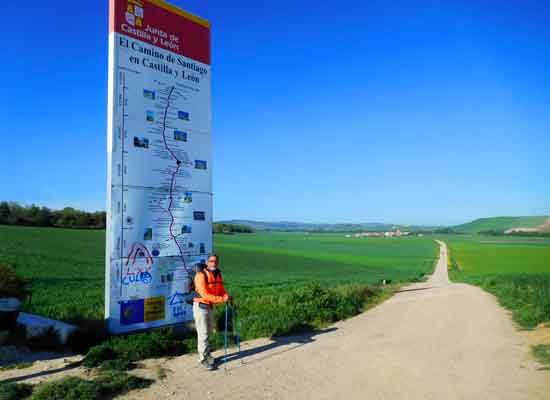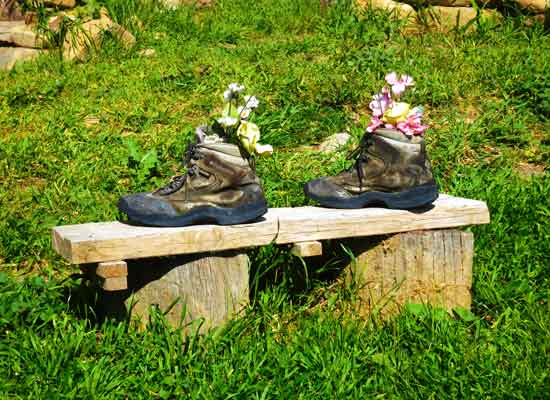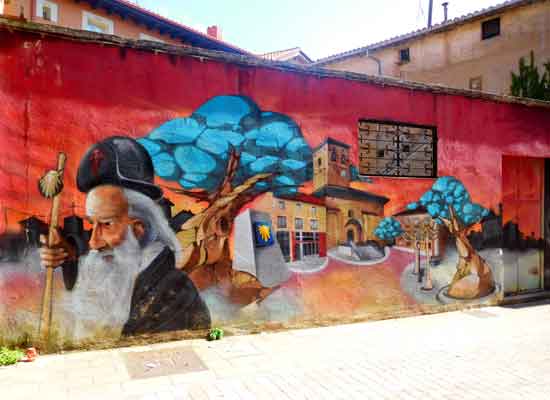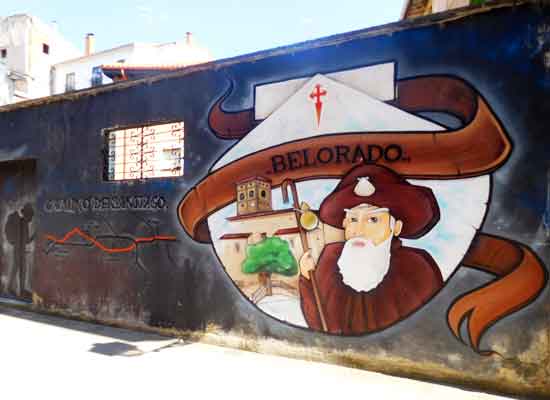Step by Step along The Way of Saint James
From Santo Domingo de la Calzada to Belorado
20 May 2018
Stage 10 – Km. 23

At the first light of dawn, at 6:40, I leave the hostel in Santo Domingo de la Calzada.
The sky is clear, and although it is a bit colder than usual, it promises to be a beautiful sunny day.
As often happens, given the time I start walking, I set off without breakfast and wait to find an open café in the first village I will come across.
Leaving Santo Domingo de la Calzada, I cross the río Oja via a sixteen-arched bridge, 148 meters long. At the start of the bridge stands the small Ermita del Puente.
Built around the mid-11th century to aid pilgrims in their journey, the bridge has witnessed numerous miraculous events in the past.
Among these is a miracle attributed to Saint Domingo: a pilgrim who had died after being run over by a cart pulled by two bulls was brought back to life through the Saint’s intervention. This event is celebrated every 11th of May with the procession of La Rueda.
The initial stretch of today’s stage is almost entirely flat, and I cover it without any difficulty.
Shortly after seven, the rising sun provides a bit of warmth, and as it climbs higher on the horizon, it enhances the landscape’s beauty, brightening the colors of the fields and accentuating the contrast between light and shadow.
Sitting on a bench in the middle of the fields, I see another friend I’ve met along The Way: his real name is Larry, but even today, as when he was a child, he prefers to be called Yogi, just like the famous cartoon bear.
He’s from New York, and I struggle to keep up with his fast-paced American accent, despite frequently asking him to speak “slowly.”
Nevertheless, Yogi is very friendly and sociable, and every time I meet him, it’s a pleasure to exchange a few jokes.
He’s sitting here adjusting the elastic bands he wears on his knee and ankle as support for the tendinitis he’s dealing with.
I take the opportunity to snap a souvenir photo with him—both of us sitting on the bench like Forrest Gump, but without the chocolates.
After walking the first seven kilometers of today’s stage, I arrive at the small village of Grañón.
The first thing I do is have breakfast in a bar and refill the two water bottles I carry with me.
Right now, the priority is to refuel, as I’ve already been walking for an hour and a half without eating anything.
After putting some “fuel in the tank,” before setting off again, I take the opportunity to visit the renowned Iglesia de San Juan Bautista.
Built between the 14th and 15th centuries, the church has a single nave, and inside it, the Romanesque baptismal font and the large altarpiece of the main altar dedicated to the saints named John stand out. The latter is a richly decorated piece, adorned with figures full of movement.
At the back of the church, above, there is a choir with eighteen seats.
Unfortunately, there’s no sign of the famous priest, Jesús García, who welcomes pilgrims in a special way and also acts as a guide during visits to the church.
Leaving the village of Grañón, the dirt path runs through a lovely landscape still made up of gentle, green hills covered with the usual blanket of cereal crops.
The sun is already high, and the temperature has become pleasant.

Shortly before 9:30, I am walking with Rocco and Dante as we cross the border between the provinces of La Rioja and Castilla y León.
To commemorate the moment, we pose for some photos in front of the large sign marking the change of province.
At Redecilla del Camino, a vending machine located along the road—similar to those dispensing drinks and snacks—serves as a “pharmacy for The Way of Saint James,” containing medications and supplies useful for the ailments of travellers.
This is yet another example of how, in these small villages, everything is designed to meet the needs of pilgrims: the constant flow of people contributes, in some way, to sustaining the local economy.
– No one gets rich, and no one takes advantage! –
In this account, I have frequently mentioned the prices of hostels and the so-called “pilgrim menus.” I have also referred to the “donativo,” the practice of offering something in exchange for a voluntary donation, and the various accommodations run for free by volunteers.
These few examples are enough to understand that behind The Way of Saint James, there is no large-scale profiteering. However, it is also true that the overall numbers are impressive, considering how many people walk all the routes leading to Santiago de Compostela each year.
Official statistics for 2018, the year of my journey, report that over three hundred thousand pilgrims arrived in Santiago de Compostela, more than fifty percent of whom walked the French Way.
Other significant figures refer to the two locations where the highest number of pilgrims started their journey: nearly thirty-three thousand from Saint-Jean-Pied-de-Port and more than eighty-eight thousand from Sarria, the town marking the last hundred kilometres.
Walking The Way of Saint James typically costs around 25/30 Euros per day, a budget that covers accommodation, dinner, breakfast, and other snacks throughout the day.
After listing all these figures, it’s easy to do the math and estimate that we’re talking about millions of Euros entering Spain through this “alternative” tourism. Money, however, is distributed along the thousands of kilometres of the various routes leading to Santiago de Compostela (the French Way alone is approximately eight hundred kilometres).
Given these considerations, my thoughts quickly turn to the Italian Via Francigena. I should clarify that I haven’t studied it in depth, and my knowledge is based only on sporadic information I’ve read or heard.
Although our domestic routes, from a historical, artistic, and natural perspective, are undoubtedly superior in beauty and cultural interest compared to other places in the world, there are several practical and economic differences that fail to match the various Ways of Saint James. These differences explain why the Italian Via Francigena attracts only a few tens of thousands of walkers each year.
Firstly, there’s the daily budget required in Italy for accommodation and meals: in our country, the costs are at least double, if not more, compared to Spain. This is a significant factor, considering that anyone embarking on such an experience needs to sustain themselves for several weeks, if not more than a month.
Favouring Spain, one must also highlight the extensive network of facilities along The Way, not only hostels and small restaurants but also bars, markets, and other services that are relatively frequent along the route; the precise and well-maintained signage that, step by step, leaves no doubt about which direction to take; and the network of paths and trails dedicated to walkers, which, for the most part, allow pilgrims to walk more or less away from busy, motorised roads.
By investing in these basic aspects, over time, it would be possible to develop in our peninsula a substantial share of tourism made up of those who walk long distances.
There are probably also bureaucratic issues to be addressed in Italy, but I’ll leave these aside, given my limited knowledge of the matter.
I have spoken about The Way of Saint James based on what I was able to observe firsthand; in my eyes, there were many positive aspects that lead me to give a high rating to the practical side of this experience.
If there are negative aspects of The Way of Saint James that I failed to notice, or inaccuracies in what I mentioned about the Italian situation, I am ready to acknowledge facts that contradict what I have written.
***
After these reflections on the economic aspects of The Way, I return to recounting today’s stage.
Leaving Redecilla del Camino, the path runs alongside the main road for a few kilometers; the passing vehicles distract me from my thoughts, making me lose some of the serenity The Way so generously provides.
At the entrance to Castildelgado, another tiny village with two churches, a square, and just a handful of houses, I meet Tunner, a cheerful young man from Seattle who temporarily left his job as a carpenter to walk The Way of Saint James.
A little further ahead, I make the acquaintance of a new friend, Maico—an energetic Dutchwoman from Amsterdam who moves swiftly, supported by her “bordón” (walking stick), adorned at the top with both the “concha” and the “calabaza.”
The “concha,” as I have already mentioned, is the shell symbol of The Way. The “calabaza,” on the other hand, is a small gourd, shaped like a flask or a pear, which ancient pilgrims used as a container for water or wine.
Today, it’s mostly a symbol and is commonly sold as a souvenir.
Maico is energetic and fast-paced, but she occasionally likes to take long breaks, enjoying a rolled cigarette and, when possible, a cup of tea or coffee.
It’s during one of these pauses that Rocco and I meet her, finding her seated on the ground, resting in the shade of a massive pile of hay bales stacked in the middle of the countryside.
We also take a short break while exchanging the usual introductory chit-chat among pilgrims—Where are you from? When did you start walking? How long have you been on The Way? Where will you stop tonight? Are you doing the full route or just a part? Will you also go to Finisterre?—and so on.
Generally, this is the spontaneous “protocol” followed when meeting a new companion on The Way. If the conversation continues, it often includes details about physical ailments caused by the many kilometers walked. These are sometimes discussed not so much as complaints but rather with a sense of pride, like war wounds earned during an epic battle.
As we leave, Maico lights another cigarette, and we jokingly warn her to be careful not to set fire to the mountain of hay she’s leaning against.
A little further on, we reach Viloria de Rioja, a village covering just seven square kilometers with fewer than sixty residents.
This tiny settlement is famous as the birthplace of Saint Domingo, who was born here in 1019 in a small house facing the Iglesia de Nuestra Señora de la Asunción.
Inside the church, there is still the Romanesque baptismal font where the Saint was baptized.
I pause for a few minutes inside the church while Mass is being celebrated.
In the same village, there is also the private hostel Acacio y Orietta, which offers pilgrims the opportunity to send a message to Paulo Coelho, the author of the famous 1987 book “The Way of Saint James,” which played a significant role in reviving interest in this pilgrimage.
In Viloria de Rioja, I meet two more friends I’ve already encountered along The Way: a father and son who live in Mexico City.
They both tend to maintain a very brisk walking pace. The younger son, Eduardo, is small but athletic and walks at a steady rhythm, almost like a metronome.
Eduardo’s steps are marked by the tapping of his poles, which strike the ground alternately and consistently as he moves forward.
His father, on the other hand, has softened the noise of his poles by attaching old tennis balls to the tips.

Along the path to Santiago, in addition to the traditional symbols of The Way, there are often modern ones, spontaneously created by today’s pilgrims. For example, it’s common to see old hiking boots repurposed as planters, filled with soil and flowers, either by the roadside or atop mile markers.
Sadly, it’s also not uncommon to see memorials or simple crosses commemorating pilgrims who have passed away. These often feature photos and handwritten messages dedicated to loved ones—some who died during their pilgrimage and others who had a connection to The Way or someone who walked it.
Around noon, I arrive in Villamayor del Río, another tiny locality known as “The Village of Three Lies” because it is not a “Villa,” it’s not “Major,” and it has no “Río.”
Before moving on, I take a moment to visit the neoclassical-style church dedicated to Saint Gil Abbot, dating back to the 18th century.
Since Mass is being celebrated inside, I sit quietly in the last row, using the opportunity to rest for a few minutes.
The last kilometers of today’s stage lead me along a dirt path bordered by the familiar green agricultural fields.
Shortly before 13:30, I reach Belorado and stop at the Albergue municipal El Corro.
The hostel is comfortable, though relatively small.
We are warmly welcomed by Minerva, a young and charming lady who runs the establishment.
I’m pleased with my choice, although I probably could have opted for something better, as the town also offers more structured accommodations, some even with a swimming pool.
The sun is shining, and after taking a shower and doing my laundry, I enjoy a mid-day snack in the hostel’s courtyard. Some fellow pilgrims are also there, and we chat pleasantly between bites.
After a nap, I take the usual afternoon stroll to explore the historic center of Belorado. Rocco and Dante join me.
We first head to the lovely Plaza Mayor—a trapezoid-shaped square with arcades and typical Castilian architecture.
In the center stands the “templete,” an elevated, octagonal gazebo.
What captures my attention most, however, are the many plane trees filling the square.
At this time of year, the trees are bare, and their intertwining branches create an enchanting pattern.
It’s easy to imagine how, in summer, their thick foliage forms a natural canopy providing shade from the scorching sun.
On the eastern side of the square stands the medieval Iglesia de San Pedro, later modified in the 17th century.
While admiring the square, we meet three young Korean friends we got to know a few days ago. We spend a few minutes chatting and exchanging smiles.
They teach me a gesture that young people in Korea often make—crossing the thumb and index finger of the same hand into an “X” shape, which means “love.” If the love is great, they raise both arms above their head to form a heart shape.
We take some fun photos together making these signs, and the girls also pose with the “V” sign using their index and middle fingers—often interpreted as meaning peace, victory, or simply to add a natural smile to the face, much like saying “cheese.”


***
The town of Belorado is also an open-air contemporary art exhibition; many walls and facades of houses and buildings feature large, colorful murals inspired by the theme of the 2010 Holy Year and beyond.
One of the most beautiful aspects of spring is the storks that, as every year, return to occupy the tops of bell towers, towers, or even simple utility poles, becoming an integral part of the places where they nest.
Their large nests, made of branches and twigs, along with their charming occupants, are a widely seen natural spectacle here in Belorado as well.
I find it fascinating to observe them, and despite their height, I can hear the distinctive clattering sound they make by rapidly snapping their long beaks.
I take several photos, trying to capture them up close in their elegant poses.
At the end of Calle del Corro, at the foot of the ancient castle, stands the Iglesia de Santa María la Mayor. Inside, it holds important artistic treasures: the baroque altarpiece of the main altar, an ancient statue of the Immaculate Virgin, and the altarpiece dedicated to Saint James the Apostle.
In this last piece, the Saint is depicted both as a pilgrim and as a horseman in his role as “Matamoros” (Moor-slayer).
The iconography of Saint James as a warrior killing infidels, often seen in many churches, does not originate from actual events attributed to the Saint, as the presence of the Moors on the Iberian Peninsula does not coincide with the time when he lived.
The representation of Saint James as Matamoros, however, derives from a legend: in the year 844, the Saint is said to have appeared in a dream to a commander the night before a battle against the infidels, assuring him of his support in the fight and promising victory.
To reach the castle of Belorado, we ask a lady for directions. Instead of just pointing us in the right direction, she kindly offers to be our guide.
First, she takes us to the castle, whose ruins are located on a panoramic hilltop next to the Iglesia de Santa María la Mayor. After that, she suggests we visit the Convent of Nuestra Señora de la Bretonera, run by the Poor Clare nuns.
We head to the outskirts of the town, where the ancient monastic building is located. Its foundation dates back to 1358, when a community of devout women settled here to follow the rule of Saint Clare of Assisi.
Our friendly guide, a local from Belorado, leads us inside the monastery and into the church, where a few nuns are gathered in prayer.
Despite being separated from the sisters by a tall iron grate, we can still admire the single nave of the Latin cross-shaped church, especially the precious altarpiece of the main altar, which features a statue of the Virgin ascending to Heaven.
Leaving the monastery, we thank and bid farewell to our guide, capturing the moment with a photo of us together.
We hurry back to the hostel, where we are expected for dinner at 19:00.
As planned earlier in the day, I choose from tonight’s “pilgrim menu” a vegetable soup, cod, and crema catalana with cinnamon—this last dish topped with a layer of caramelized sugar crust.
To end the day, I take one last stroll through the square with my Spanish friends, Juaní and Salvador. With them, I enjoy a “nightcap” before heading to bed.
| © Aldo Lardizzone 2020 |  |
CREATIVE COMMONS |



